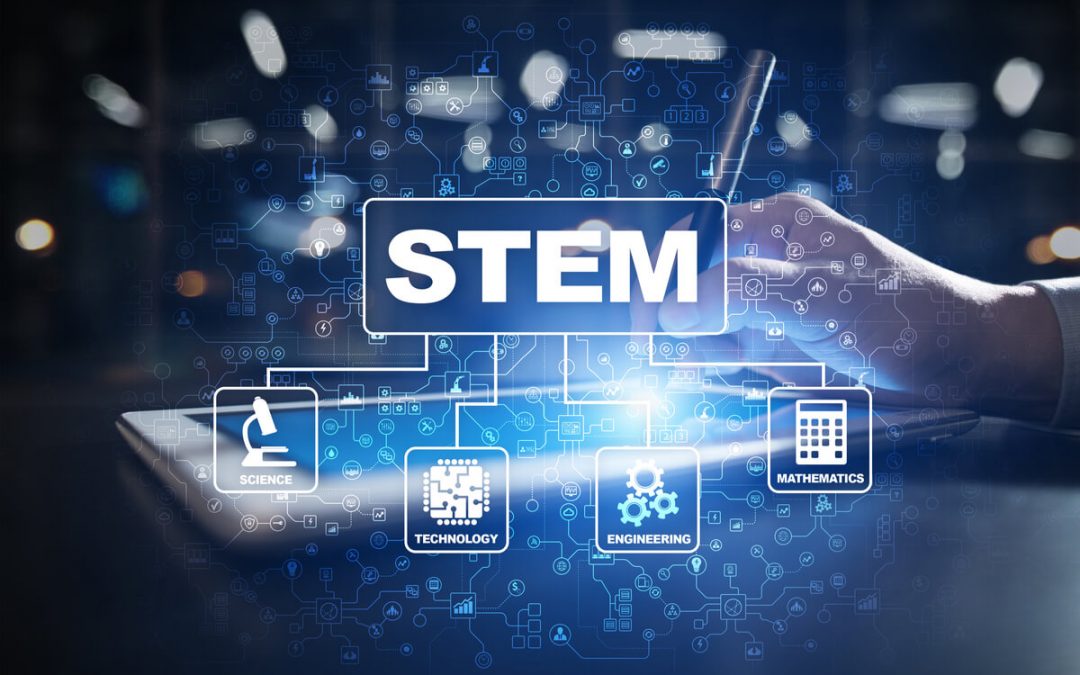
by admin | Oct 15, 2020 | E-Learning Testing, Fixed, Blog |
STEM alludes to an educational curriculum based on the idea to teach students in four specific academic disciplines: science, technology, engineering, and mathematics. Rather than teaching these subjects under separate categories, STEM education integrates them and provides a holistic learning experience. Since the subject presents absolute practicality, it reflects a paradigm shift that enables cohesive learning.
The United States of America has conventionally been a leader in these fields. However, recently fewer students are focusing on this topic. According to a report by the U.S. Department of Education, only 16 percent of the students are interested in pursuing a career in the STEM field and have proven a proficiency in mathematics. Moreover, 28 percent of high school goers have expressed an affinity by declaring a career in a STEM-related field, but 57 percent out of them will eventually lose interest by the time they graduate.
Consequently, the United States government declared an initiative known as “Educate to Innovate,” which aimed at inspiring and motivating students to join STEM-related careers. The goal is to get American children right into the hearts of these subjects, while they gain traction in the international arena. The government has further invested $3.1 billion in federal programs on STEM education.
The Significance of STEM Education
STEM careers are growing in popularity. According to a report conceded by STEM Connector, by 2018, projections estimate that there will be a spike in stem-related jobs, and the demand would rise to 8.65 million workers. The manufacturing sector has been facing an alarmingly substantial shortage of workers who are proficient in this field. The report accounted for their number to be nearly 600,000. Furthermore, the U.S. Bureau of Labor Statistics assessed that by 2018, the major STEM careers would be:
- Computing – 71 percent
- Traditional Engineering – 16 percent
- Physical sciences – 7 percent
- Life sciences – 4 percent
- Mathematics – 2 percent
United States has continually been the champion of STEM education careers. However, studies have shown that all of it is just to meet a need, fill in the demand gap when the markets are high. Not all STEM jobs necessitate higher education or even a college degree. Less than half of entry-level jobs require a bachelor’s degree or higher. However, a four-year degree instead of a diploma would be incredibly helpful with salary. Surveys have further shown that the average advertised starting salary for STEM jobs with a bachelor’s degree is 26 percent higher than the non-STEM fields. For every job posting for an individual who possesses a bachelor’s degree in a non-STEM field, there are 2.5 more entry-level job postings for an individual who has acquired a degree in a STEM field.
Combining Culture
Do you know what separates STEM from conventional math and science education? Yes, it is the holistic environment that the discipline presents. It teaches students computational skills and helps them focus on real-world problems while applying their knowledge to practical and realistic situations. STEM education begins when children are very young, and the skills are inducted further into their middle and higher school studies.
Elementary school – STEM education at the elementary level focuses on the introductory level courses, as well as a comprehensive awareness about career options and occupations. It is the primary step of induction and motivates children to pursue a career in the field. It further provides structure and opens up a channel for inquisitive students who have legitimate inquiries. It further prompts students to solve real-world problems while developing their aptitude.
Middle school – As the students transcend into middle school, the course becomes rigorous and challenging. The awareness is still furthered; however, the academic requirements of the field are unleashed onto the students. For under-represented populations, student exploration teams formulated by STEM begin recruiting students at this level.
High school – Course pathways are now laid down as the children tumble into high school. An inclusive and wide-embracing approach has opted, and students are taught to apply the subject in realistic scenarios. Learners are further taught as well as prepared for post-secondary education and employment. The goal is to pique their interest. The course strives at students wanting to pursue a career in the field, rather than being forced to have to. It also emphasizes bridging learning opportunities, both in and out of school.
A large portion of the curriculum is aimed at attracting under-represented populations. For instance, female students are far less likely to pursue a college major or career. Though it is not something we as a community witnessed momentarily, the gap is significantly increasing. Therefore, the curriculum focuses on amplifying every section that under-represents their role in prudent fields. Moreover, the discipline aims at deescalating stereotypes such as male students preferring to opt for engineering or technological fields, while female students stick themselves to science, like biology or chemistry. However, it must not be the case since education must be open to all, equally.
Although bridging the gap that has already been created in the impressionable minds of students is challenging, the feat is not impossible. The field also witnesses ethnic under-representation and over-representation. For instance, students with Asian descent have historically displayed more interest in the field. Prior to 2001, children from African-American communities also showed higher interest levels, second to only the Asian demographic. However, since then, the statistics for the community has plummeted drastically, far more than any other ethnicity.
To Wrap up
The importance of STEM education has been re-iterated over the centuries, where humans have stood witness to revolutionary inventions and medical marvels. Therefore, furthering the students to pursue a career that will help evolve mankind is imperative. STEM education presents opportunities that only a few fields can offer. With doctors and engineers commanding the highest salaries, the world runs at their behest. Not only would we be incapable of accessing the phone, but the disruptive invention of high-speed internet is also something that has gotten our hands tied and lips sealed today. Therefore, promoting your child to craft a career in the most prosperous field could be a prudent choice.

by admin | Oct 12, 2020 | Game Testing, Fixed, Blog |
With the gaming world expanding day-by-day, the game testing industry is also expanding with this time. People are actually getting paid for playing mobile games in order to test them, and this method is getting pace with each day. Moreover, it is not only about playing games while sitting on your couch, but it is about performing different tests on the game to know more about its design and gameplay.
However, there are some key areas that you can follow to test a game. The list is given below with a brief description.
Interface Testing
The first thing that the developers should test is the interface, as it is that feature that appears first when a game opens/starts. In this testing phase, you can view how does the game looks? How is the user-interface? Is it user-friendly or not?
You can start from the onboarding point because this section lays the first impression of the game. If this section is too long, it will bore your customer, and he will end up switching to some other game with a better start.
The layout of the elements present on the main page of the game should be clear, well arranged, and these elements should adjust themselves according to the screen of the cell phone.
Graphics Performance
Even if your UI is great and the layout is amazing, if your graphics are not up to the standard, you are not getting the right attraction. The game testers need to ensure that your game’s performance remains the same on all the devices and graphics stay intact and clear. A slight issue can put the gamer off, and he/she is not coming back to play your game.
Security Testing
After testing how the game will be played and how its graphics will be on every supported device, then comes the part where the game’s security must be tested. Game Testers must ensure that the ads and other third-party gateways must not be used by the hackers to intrude into the user’s cellphone and take away all the data.
This security testing has become a make or break area for the developers because everyone loves their privacy. If a hacker can hack into your phone with the help of a game, we are sure you will never play that game again.
External Devices
Nobody wants to keep playing a game on a small screen, and those who play games non-stop want the cell phones to be connected with bigger screens. Game Testers should ensure the devices’ smooth attachment to the bigger screen and then the streamlined working of the game.
Functional Testing
This kind of testing can help you to know when your game is performing high and when it is going low. With this test’s help, you can work on the performance, graphics, and compatibility of your game with different devices.
Conclusion
Overall, we have listed the most important tests, but there are some more which the game testers can adopt while testing the game. You can perform tests like Performance, Localization, and many other tests.

by admin | Oct 9, 2020 | Software Testing, Fixed, Blog |
Becoming a successful machine learning/artificial intelligence engineer, there are certain numbers of skills required to stir a prosperous career in the field of ML/AI. Having adept about the subject of matter, understanding essential requirements and the fundamentals necessary to build a successful career in the field of artificial intelligence or machine learning.
Machine learning is an innovative technology that employs logical algorithm and statistical models to carry out specific tasks, such tasks are being completely achieved through system self-learning of complex and important trends from a given dataset and drawing an inference for useful insights and conclusion. Whereas, artificial intelligence is a wider aspect of machine learning that employs human cleverness to machines in other to be able to autonomously process, learn, think and lastly make intelligent adjustments or corrections. Artificial intelligence was built to work autonomously without engaging the computer programmer for explicit coding of each part of the AI system.
Skills Required By Machine Learning Engineers
A quality and qualified engineer looking for an amazing career in the field of ML/AI needs to possess an in-depth knowledge of data science and statistical implementations; also, some fundamental know-how on software engineering and data handling. Some of the important skills required by aspiring ML/AI engineer includes:
Basic computer programming knowledge
A fundamental knowledge about software building and implementation ranging from linear programming, computer structural design, data architecture, to algorithm optimization as all needed as a ML/AI engineer. This engineer will also engage in simulating machines to carry out activities same way human beings does. An engineer without this basic programming knowledge will find it difficult.
Data handling and validation
Data handling skills is very important in ML/AI building and implementation. These skills is highly required by the intending engineers to perfectly identify different trends and patterns available of gathered datasets. Without this skills, proper data handling and validations can’t carry out.
Statistics and Probability
Data science was based on statistical modelling, a very crucial part of ML. An intending ML/AI engineer must be skilled in carrying out probability theories like Markov models, Bayesian principles, amongst others. Also, such an engineer must be capable of performing univariate and multivariate statistical analysis that forms the fundamental of ML models.
Software design
Long-term product of building a ML/AI system is incorporation into software either on PC or Smart phones. An engineer of ML/AI requires to have these skills for final representation and deployment of the developed model into software, this will provide a user-friendly interface for proper application.
Signal processing skills
Knowledge of signal processing is required to extract features and solve complex problems. This is a crucial aspect of ML that includes feature mining that will enable algorithms like Shearlets, Bandlets, and Wavelets perform theoretical analysis in solving multifaceted scenarios.
Architectures of Neural Network
Tasks that are beyond human capabilities are execute by Neural Networks. This network has demonstrated to be one of the most accurate ways of deciphering problems like Object recognition and classification, speech recognition, natural language processing, and many more.
Good understanding of Algebra and Calculus
Having an in-depth knowledge of Calculus, Matrices, Vector, Algebra, and others are very vital in understanding and representing some ML/AL concepts.
Physics
This is one of those basic knowledges required by ML engineer. It aids in the representation of complex situation and inferring of the situation.
Domain Knowledge
Knowledge of the field of subject matter, a machine learning engineer must be vast in of problem identification and solving to be able to design a nearly perfect model for useful insights and interpretation.
Fast Prototyping
The available for building and implementing an ML system is expected to be reduced to the barest minimum. This can only be achieved an engineer that knows how to select right model in carrying out certain excellently. It also includes weighing up different methods to achieve a faster model for implementation.

by admin | Oct 5, 2020 | Game Testing, Fixed, Blog |
Game testing is an important part of the development of games because these tests and gaming testing techniques tell the developers whether their game is ready for launch or not. These gaming testing and techniques provide a critical eye for constant searches such as errors, coherence, completeness, etc. So, without wasting any time, we will provide you the top best seven different types of game testing techniques.
Functionality Testing
This testing is done to confirm the end product’s smooth working with all the specifications and modifications. The Quality Assurance testers go for the graphics, user interface, stability and audio-visual issues, and other mechanical problems in this testing. Game testers also ensure the user-friendliness of the game through this game testing technique.
Combinatorial Testing
This test allows you to check the game’s compatibility according to the given requirements on different devices. Through this testing, you can analyze and scrutinize the game’s inputs to get a clear image that is concerned with different images and combinations. This technique helps the developers to see the effectiveness of their game during the execution and phase containment.
Ad Hoc Testing
A general testing is often referred to as Ad Hoc testing because, in this testing, game testers can test any section of the gaming application randomly. However, this testing focuses on guessing the errors, and they require no documentation or planning for this. Game testers can adopt Adhoc testing such as Pair testing, Buddy testing, and Monkey testing.
Compatibility Testing
This testing’s main aim is to detect the defects which are present in the functionality of the game and helps the developers to meet the essential requirements of the software, hardware, and graphics. Through this testing technique, game testers can ensure that the game can be played on all kinds of screens and handsets.
Clean Room and Tree Testing
The clean room testing technique ensures the gaming software’s stability and reliability. The main aim is to get a product that has negligible errors and what’s good about this testing is that you don’t have to prepare any content for it to start your test. While Tree testing basically helps the game testers choose tests that are best suitable for their game, they can generate their codes.
Regression Testing
Game testers can use this testing technique to scrutinize all the features of the game and analyze its working. This testing’s core idea is to check whether the game is working fine or not and whether any changes in the game development can cause bugs. Moreover, this testing technique helps maintain the quality of the products, and testers can spot all the bugs present in the gaming software.
Performance Testing
It could be considered the last testing technique, as it determines the application’s overall performance. This can include the load time, real-time scenarios, detects any delay time in the game, and much more. Game Testers can use this technique to optimize the product speed, network connectivity, battery consumption, response time, etc.

by admin | Sep 28, 2020 | QA Outsourcing, Fixed, Blog |
Are you thinking about choosing a testing or QA vendor? If your answer is yes, then you’re in the right place. Read on to learn what factors to consider when it comes to choosing a testing vendor.
The financial and technical success along with failure for several testing projects relies on picking the right vendor. Comprehending the main procedures will lead you to select the right testing vendor and make wide decisions that benefit your organization. Before picking a testing vendor, it is critical to analyze factors such as testing strategy and credibility. So, it would be possible for stakeholders to choose the best testing vendor by following specific norms for their testing project and the company.
When & Why Outsource Software Testing?
Software testing outsourcing enables enterprises to concentrate on their critical operations and accelerate creativity. Simultaneously, the testing service providers operate efficiently and effectively to ensure higher product quality as well as a positive business outcome.
When you work with QA professionals to do the testing task, it saves the organization’s time and resources regardless of project scope and duration of testing needs.
Below is why you should go with a professional QA vendor:
- Accomplish cost benefits
- Dampened in-house efforts
- Access to a highly proficient team
- Independent AQ
- Enhanced application quality
- Thoroughly tested final products
Key Factors for Choosing a Testing Vendor
When it comes to choosing a testing vendor, the following factors can help you make a wise decision.
Ability to Communicate
QA vendor is like a central location where all info comes and goes. Therefore, they should express all the knowledge that comes across and attempt to send it back to all categories of individuals. A software/application tester’s most valuable ability requires high levels of communication skills. As a quality assurance person, the testing vendor has to connect with the developer, product manager, product designer, and CEO. So, he or she should have the capability to communicate with multiple organizational levels.
Ability to Think
His / her ability to think is another valuable quality a testing vendor should have. He/she should acknowledge that testing is not about checking boxes and ticking boxes. Instead, it’s about thinking and posing a question about what the problem is. The testing vendor should have excellent analytical competence. They should think and understand and engage with their products to provide their stakeholders with valuable information. The perfect candidate must have ‘out-of-the-box’ insight and be able to address emerging market patterns.
Service Level Agreement (SLAs)
It is the contract signed between service providers and customers that define the service provider’s expected output. To ensure 100 percent compatibility of your goals between the service provider, it is essential to define SLAs beforehand. SLAs should be correlated with the engagement model, the KPIs, and the sort of testing.
Quality Improvement
One of the client’s key goals is to accomplish a significant quality enhancement via outsourcing. If the contract matures, the process and operating methods should be tried to enhance continually. The ultimate aim should be to improve the end product overall.
Change Management
There may be frequent changes in requirements from the client’s end that affect the test cycle, if not managed correctly. Service providers should develop a robust change management mechanism to address the additional cost, time, and commitment to addressing the requirements.
Reputation
The measure of reliability and importance your potential associates have on the market should be considered. This can indicate your overall skills and leadership in thinking. Typically, well-established firms are viewed in terms of experience level rather than start-ups. Often make sure that you review references with a thought of how each competitor is performing. Honors are an excellent symbol of the organization. Evaluating their user base is much easier to consider the extent of skill and the areas of excellence. Finally, analyze their client base so you can better understand the level of skill and specialized topics.
Security
Securing data is very imperative from a business perspective. Outsourcing companies provide guidelines & norms for information security. Many QA vendors get their dedicated team to work in an ODC (Offshore Development Center). Only the team for a specific project works for a particular client. In ODCs, the entry of any external personnel is prohibited.
Intellectual Property Protection
The protection of IPR is one of the essential things to consider when outsourcing the services. One of the significant issues when outsourced is protecting the intellectual property of the companies. The vendor should secure the customer’s Personally Identifiable Information (PII). It is not be utilized for any reason other than the intended business.
Do Not Stick To Just One Vendor
Consider at least three to five vendors. You may have one as your choice in mind, but you never know what the others have to bring. Therefore, we suggest that you pick at least three to five vendors, who are the true reflection of different competitive companies out there for the solutions you are looking for.
Allocate Enough Time To The Selection Process
Ensure you allocate enough time for both yourself and the team to provide the feedback and the selection process itself. It takes time to do an evaluation. Often the assessment of a small number of vendors can take several weeks to decide which one you should go with. You shouldn’t hurry the process and take the time required to do a proper evaluation.
Consider The Type Of Outsourcing
There are several kinds of outsourcing. There may be onshore that can be on-site or offshore outsourcing can be near the shore. You should bear in mind what type of outsourcing plan to go ahead with the selection process and get the management team on board.
The Final Verdict
In almost every organization, testing or QA vendor is needed. There are many options out there on the market when it comes to a testing vendor. Before you delegate the work to new hands, careful & thoughtful consideration is required. You must adopt the vendor’s profile to your testing needs and make a vendor’s evaluation based on those parameters.
That’s it; now, you can sit and relax as you got to know every aspect of choosing the right testing vendor!

by admin | Sep 24, 2020 | VR & AR App Testing, Fixed, Blog |
When you push the boundaries of Virtual and Augmented Reality and merge them to create a new abstraction level, you get Mixed Reality (MR). Mixed Reality and its applications are both incredibly ingenious and awe-inspiring. The creative leaps you used to witness in space-age movies are now a reality. MR is the new kid on the block. Let’s “immerse” ourselves into MR to understand more about this new technology.
What is Reality? It is not just an existential question. Over the years, human ingenuity has been continuously pushing the edges of Reality, reinventing what we perceive through our senses. Virtual Reality (VR), Augmented Reality (AR) has been around for some time, and most of us have some experience with them. VR of today is not the same you might have experienced a few years ago. It doesn’t mean that you have to strap a bulky computer on to your forehead and have a painful experience (those were the old days), today’s devices are smarter lighter and allow more engagement.
Regarding Augmented Reality, many of us noticed how Pokémon Go exploded on to the scene; the app was downloaded over a billion times and was extremely popular. The game used the GPS on the user’s phone, and virtual Pokémon were imposed on the user’s surrounding environment as viewed through the phone’s camera. This virtual interface layered with real physical objects and virtual characters is how the player felt connected as the imaginary Pokémon real overlaid the environment.
Virtual Reality (VR) focuses on replacing your immediate surroundings with something different; for example, you can feel transported to the beach while still sitting in your living room. To accomplish this effect, VR uses devices that engage your two senses of vision and hearing. These devices, typically headsets, engulf your vision to cover your peripheral vision as much as it can so you get the feeling of being “in” the new environment. Using headphones, you also get detached from the surrounding sounds and only hear what is meant to be in the Virtual Reality you are experiencing. There have been quite some advancements in the development of these headsets. Oculus Rift S and HTC Vive are some of the highly-rated VR headsets. VR is an entirely virtual space that people can enter and have popular games, virtual tours, and travel applications.
Augmented Reality(AR), on the other hand, is about overlaying images and virtual objects over real-world surroundings. So the Pikachu sitting on your sofa in the Pokémon go game is an example of AR. With AR, you are not having an immersive experience as you can still manipulate the real surroundings while interacting with the virtual characters on your device. The use cases are in games and often used in manufacturing and supply chain in warehouses. Think about walking down the aisle in a warehouse with your device pointing at the long array of boxes. The app analyzes the right pick location and highlights it in real-time on your device, suggesting the correct place for your pick.
Mixed Reality (MR) lies somewhere between these two extreme ends. MR overlays virtual objects on real-life surroundings and gives a unique perspective. It provides a semi-immersive experience as you still view your real surrounding with additional overlays, and you don’t get locked away in a virtual experience of a VR. The applications for Mixed Reality are creating a significant buzz. Market research on Augmented and Mixed Reality, performed by Juniper Research, considered that VR/AR applications would reach over 10 billion installations by 2024. The market will be over $43 billion in the same year.
Components of Mixed Reality
MR experience lies somewhere between VR and AR. It seamlessly mixes the virtual world of VR and brings in the real world of AR. MR allows the user to interact with both worlds. While AR improves the user’s perception of its surroundings, MR can make potentially make virtual aspects indistinguishable from Reality.
There are primarily two types of devices that are used to create MR.
Holographic Devices – These devices create holograms and images that are virtual and project them on to the real world of objects; for example, you can see the body and outline of a person juxtaposed on a chair next to you with such a holographic device. Example Microsoft HoloLens 2
Immersive Devices – Immersive devices help conceal the real elements in the surroundings and replace them with digital creations. Example Samsung HMD Odyssey.
Such immersive devices allow users to achieve maximum isolation into the virtual world from a real-world dimension. Developers focus on building headsets that enhance the experience by using techniques such as eyeball tracking and increasing the field of view.
Applications of MR
Developers are only beginning to explore the possible scenarios where MR can be effectively used. As of now, fields such as education, training, sports healthcare, engineering, and construction are finding the best use of mixed reality technology.
Education – Medical students, for instance, can now use MR to visualize human anatomy; the entire education sector stands to gain by having courses redesigned to incorporate MR and help in better assimilation. Case Western Reserve University in Ohio took advantage of the Microsoft HoloLens 2 to learn anatomy.
Sales – Imagine a medical sales representative explaining how the medicine interacts with the human body. Both the doctor and the representative can engage in MR and visually see the effect and engage in manipulating parameters.
Engineering – Applications can use MR to project 3D or 4D design models over the actual structures which are being constructed. It can help them understand the progress and focus on improving quality.
Training – Manufacturing companies are using applications built on HoloLens to remote train engineers and help fix problems. A major automaker in Japan is training its counterparts in Mexico in this pandemic and saving time and money on the movement of resources across countries for training and support needs.
Remote Meeting – Now, you can attend remote meetings and interact with others using their avatars in a real room setting. Spatial, a startup focused on augmented and virtual reality solutions, has developed an application that allows you to attend meetings. It’s now claiming that you can do that without a headset!
Healthcare – “Using HoloLens is like having an x-ray vision”, claims Karl West at the Cleveland Clinic. The HoloLens can fit over a surgeon’s head and displays images that hover in the surgeon’s field of vision. The apps align images of the patient’s anatomy with the real-life view. The images come from previously taken CT scans or MRI, but are projected holographically via the head-mounted device.
Conclusion
Mixed Reality brings the immense potential to change how people interact, work, and collaborate with real objects worldwide. As other technologies such as faster chipsets and 5G continue to evolve, it’s expected that MR, too, will mature, and there will be more readily available applications of MR in more industries and sectors.
Other factors, such as acceptable social etiquette while using MR, will also need to be considered. When we see an image on a screen, we know it’s virtual, and it’s limited within the screen. However, we may not anticipate people’s emotional reactions to real-life virtual images and objects in real-world settings. As MR technology develops, it will be crucial for the developers to focus on this aspect. Aspects of intended use and privacy need to be studied and taken into account.



























